Understanding Outdoor Termite Bait for Effective Pest Control


Intro
When it comes to safeguarding your home against pests, understanding termites is essential. These relentless invaders can turn a livable space into a structural hazard before many homeowners even notice. That’s where outdoor termite bait systems come into play. Designed to outsmart these wood-devouring pests, these baits serve as a frontline defense in effective pest management strategies. This comprehensive guide aims to sift through the layers of outdoor termite bait, exploring their various types, mechanisms, and best practices, while also emphasizing the ecological implications of their use.
Understanding Pests
Definition of Pests
Pests are organisms that can cause damage to human structures or interfere with human activities, often regarded as nuisances. In the realm of pest control, termites stand out due to their unique feeding habits. Unlike other pests that may simply invade spaces, termites actually consume wood, impacting the structural integrity of houses and other buildings. Learning to identify these individuals is the first step toward effective control.
Importance of Pest Identification
Recognizing what you are dealing with is critical. Not all pests warrant the same approach. Take ants for example; some types might only seek food, while termites actively seek to destroy homes. Identifying these differences can save you time, money, and headaches down the line. An understanding of pests informs how you should respond and the systems you'll employ, affirming that knowledge is power in the fight against infestations.
Prevention Techniques
Preventing termite infestations is a multi-faceted endeavor that combines observation and proactive measures. By establishing preventative techniques at home and in the garden, you can significantly reduce the chances of a termite attack.
Home and Garden Preventative Measures
- Moisture Management: Termites are attracted to damp environments. Ensure that gutters are functioning properly, directing water away from the foundation.
- Proper Landscaping: Keep firewood, mulch, and plant branches at least 12 inches away from your home to avoid creating a buffet for foraging termites.
- Sealing Entry Points: Termites can squeeze through very small cracks. Seal any gaps in your home’s foundation and around utility lines.
Seasonal Prevention Tips
With changing seasons come different risks for termite infestations. In spring, when the sun starts shining bright, termites tend to swarm, so it's crucial to be vigilant. In warmer months, check for any signs of wood damage and moisture issues. Finally, fall is a good time for a comprehensive review of your home's exterior.
Eco-Friendly Pest Control Solutions
The surge in awareness regarding environmental health has led to a demand for sustainable pest control methods. An eco-friendly approach not only tackles the infestation but also minimizes harm to the surroundings.
Overview of Sustainable Practices
Using organic matter as a bait that relies on natural processes can draw termites away from your home. This represents an ethical approach that works in harmony with nature. Additionally, incorporating practices such as habitat modification—where you alter the environment to make it less attractive to pests—can be effective.
Natural Remedies and Their Effectiveness
Some natural remedies have shown promise in controlling termite populations. For instance, nematodes, tiny roundworms that are parasitic towards termites, can be introduced into the soil. Other options include the application of orange oil, known for its active ingredient d-limonene, effective against termites on contact. While these solutions might not be a silver bullet, they offer a safer alternative to traditional methods.
"Combating termite infestations requires an informed approach, combining effective bait systems with eco-friendly practices to protect both your home and the environment."
Defining Outdoor Termite Bait
Understanding outdoor termite bait is crucial for homeowners who wish to ward off infestations effectively. This section sheds light on what outdoor termite bait actually is and why it's an indispensable tool in pest management. For those caught in a battle against termites, grasping these concepts is not just useful but pivotal for safeguarding one’s property.
What Is Outdoor Termite Bait?
Outdoor termite bait refers to strategically placed systems designed to attract and eliminate termites. These baits are composed of materials that mimic the natural diet of termites, generally cellulose-based substances like wood or paper. Once termite workers discover these baits, they carry parts of it back to their colony. This not only disrupts their food source but eventually leads to the decline of the entire colony, as the bait may contain toxic or growth-inhibiting substances.
In essence, outdoor termite bait acts as a lure, drawing termites away from structures and into a trap. It's like setting a mousetrap, where the goal is to entice the critter into taking the bait and then dealing with the problem from the inside out. This method promotes a more contained approach compared to traditional spraying which can affect non-target species and contribute to further pest resistance.
The Role of Baiting in Termite Management
Baiting plays a significant role in the overall management of termite populations. When deployed effectively, bait stations not only minimize direct contact with harmful pesticides but also foster a sustainable pest control approach. Here are a few key points outlining its importance:
- Specific Targeting: Unlike broad-spectrum chemical treatments, baits specifically target termites. This precision helps reduce the chances of harming beneficial insects and pets.
- Long-Term Strategy: Many bait systems are designed to work over time, gradually reducing termite numbers without the need for frequent treatments. This long-term approach can enhance cost efficiency.
- Minimal Disruption: Since the bait is placed around the perimeter of properties, there is less intrusion into everyday life, making it a preferred choice for many homeowners.
- Adaptation to Resistance: With the ever-evolving nature of pests, using baits can deter resistance development. This is vital in managing the adaptability of termites, who often find a way around chemical methods.
"Baiting offers a forward-thinking approach to pest management, emphasizing a balance between effectiveness and environmental responsibility."
In summary, defining outdoor termite bait not only clarifies its contents and methods but also illustrates its extensive role in effective termite management. In the following sections, we will explore the various types of outdoor termite baits and delve deeper into their mechanisms and practical considerations.
Types of Outdoor Termite Bait
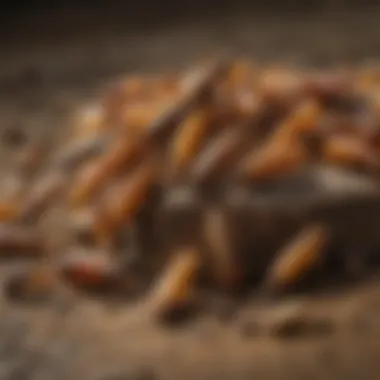
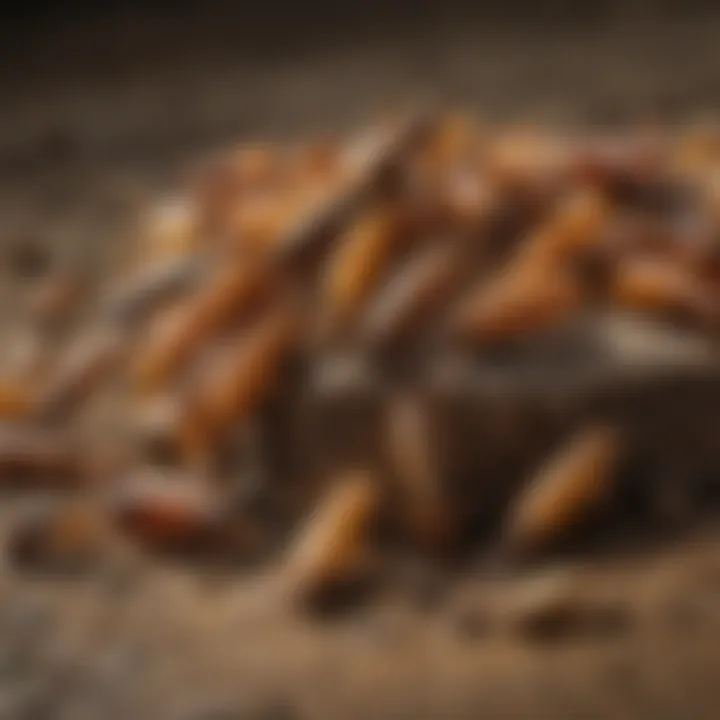
Understanding the different kinds of outdoor termite bait is essential for homeowners and professionals alike. Choosing the right bait system can make the difference between eradicating a pest problem and simply applying a temporary fix. This section will explore three primary types of outdoor termite baits: cellulose-based baits, insect growth regulators, and combination bait systems. Each has its own set of characteristics, benefits, and considerations that can significantly influence termite management strategies.
Cellulose-Based Baits
Cellulose-based baits are perhaps the most common type of termite bait and are vital in pest control strategies. These baits primarily consist of wood or paper products, which mimic natural food sources that termites find appealing. The idea is simple: termites feed on these cellulose materials, unknowingly consuming a slow-acting insecticide embedded within.
The attractiveness of cellulose-based baits lies in their dual purpose. Not only do they provide the necessary nutrients that termites crave, but they also serve as a vehicle for delivering treatment. When deployed correctly, these baits can significantly reduce termite populations over time. Moreover, they are generally considered eco-friendly, as they rely on natural feeding behaviors rather than toxic chemicals.
However, consider the location of these baits. They should be strategically placed in areas where termite activity is expected. Homeowners often overlook this aspect, assuming that simply setting up the bait will lead to results. It’s a more nuanced art and science—one that involves monitoring and adjusting as needed to maximize effectiveness.
Insect Growth Regulators
Insect growth regulators (IGRs) present a different approach to managing termite populations. Unlike traditional pesticides that aim to kill termites outright, IGRs work by disrupting the normal growth and development processes of termites. They effectively inhibit molting, which is crucial for a termite's life cycle. As a result, young termites cannot become mature adults, and the overall population begins to decline.
This method of control has its advantages. One notable benefit is its lower risk to non-target organisms, including beneficial insects. Homeowners who are concerned about the ecological impact of pest control measures may find IGRs to be an appealing choice. Moreover, because IGRs operate over a longer period, they can contribute to a sustained reduction in termite populations. However, users must be diligent. IGRs are not a quick fix, and patience is required as the baits do their work over time.
Combination Bait Systems
Combination bait systems merge the benefits of both cellulose-based baits and insect growth regulators, creating a more comprehensive strategy for termite management. These systems typically provide immediate control through a fast-acting insecticide while also introducing IGRs to prevent future infestations. This layered approach can be particularly effective in areas with a high risk of termite activity.
By utilizing multiple strategies, combination baits provide a robust defense against termites. As such, homeowners are often able to see quicker results while also establishing a long-term solution to prevent future invasions. But, like the previous options, proper placement and monitoring are crucial. Deploying a combination system improperly can erase the benefits it offers.
In summary, recognizing the different types of outdoor termite bait available is central to crafting an effective pest control plan. Each bait type has its unique advantages and considerations. By understanding the options—cellulose-based baits, insect growth regulators, and combination bait systems—homeowners and pest management professionals can make informed decisions that lead to successful termite management.
Mechanism of Action
Understanding the mechanism of action of outdoor termite bait is paramount for anyone looking to tackle termite infestations effectively. This section delves into how these baits function, their interactions with termite behavior, and the ecological ramifications of their use. By unpacking the intricacies of these systems, homeowners can better appreciate the significance of baiting as part of a comprehensive termite management strategy, and how it plays a vital role in safeguarding their homes.
How Baits Interact with Termites
The interaction between bait and termites is nuanced and strategic. Termites, as notorious wood-eating pests, primarily rely on cellulose to sustain their colonies. Outdoor termite baits are designed to exploit this reliance. Typically containing cellulose materials and a slow-acting insecticide, these baits are strategically placed in areas where termite activity has been identified. What happens next is rather fascinating:
- Termite Attraction: Termites, drawn by the scent of the cellulose in the bait, start feeding on it. They are lured to the bait stations, often overlooking the potential risks involved, like a moth to a flame.
- Chemical Impact: Once ingested, the active ingredient within the bait disrupts the termite's growth or reproductive processes, depending on the formulation. For instance, some baits feature insect growth regulators, which prevent termites from maturing or reproducing effectively.
- Colony Effect: The beauty of this method lies in its ability to create a domino effect. A foraging termite takes the bait back to its colony, sharing it with nest mates through social behaviors like trophallaxis. This means that more termites consume the bait, drastically increasing its impact over time.
The idea is straightforward yet brilliant: target the entire colony by starting with just a few foragers. Consider it like getting the ball rolling in a game of dominoes; once the first few fall, more are sure to follow.
The Importance of Foraging Behavior
Foraging behavior is a key element in termite management strategies. Termites are social insects, and their foraging habits can dictate the success of bait systems. Understanding these behaviors enhances the efficiency of outdoor termite bait by leveraging their natural instincts. Here are a few crucial points regarding their foraging:
- Resource Location: Termites communicate and navigate using pheromones to locate food. This means that an effective bait placed in a strategic location can attract not just one but a whole brigade of foragers looking for sustenance.
- Seasonal Variability: Depending on environmental cues, termite foraging patterns may vary throughout the year. During warmer months, their activity typically peaks. Homeowners should take note that installing bait stations during these times can yield better results.
- Group Behavior: Termites often forage in groups, meaning that when one termite finds a food source, others are likely to join. This collective behavior can accelerate the effectiveness of the bait.
A bait station set in a well-trafficked area of a colony's foraging path can enhance its chances of drawing in enough termites to create a significant impact.
"By grasping the foraging patterns of termites, homeowners can strategically deploy bait for maximum efficiency and effectiveness."
To summarize, understanding the mechanism of action of outdoor termite bait allows homeowners to appreciate its potency. From how baits interact with termites to the vital role of foraging behavior, it's clear that a thoughtful approach to baiting can lead to successful termite management.
Deployment Strategies
Effective deployment strategies are crucial in the battle against termites. This section breaks down the vital aspects of deploying outdoor termite bait, ensuring homeowners and pest management professionals understand how to maximize the effectiveness of these systems in pest control. Choosing the right location, installing the bait correctly, and maintaining an ongoing monitoring plan are essential steps that can’t be overlooked.
Choosing the Right Location
When deploying termite bait, the initial task is selecting the right spot. This isn’t just a roll of the dice; it’s a strategic choice. Look for areas with visible signs of termite activity—like mud tubes, damaged wood, or areas where termites are known to forage. These spots are like gold mines for baiting.
Here are key points to consider when choosing locations:
- Near Structural Wood: Focus on areas close to structures that termites are already infesting. This allows the bait to be more attractive and effective.
- Moisture Levels: Termites thrive in moist conditions. Assess the environment and seek areas with natural moisture; this can increase bait efficacy.
- Sunlight Exposure: Avoid areas that see a lot of sunlight and dry out quickly, unless you're placing baits that have been engineered to withstand such conditions.
This curation of locations enhances bait accessibility, turning those termites into an easy target for your bait system.
Installation Techniques
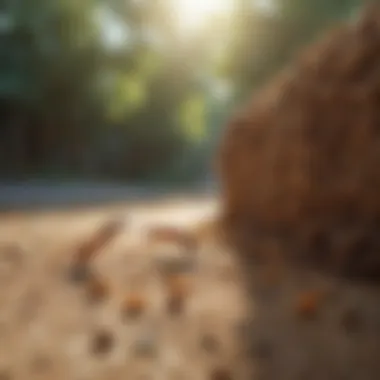
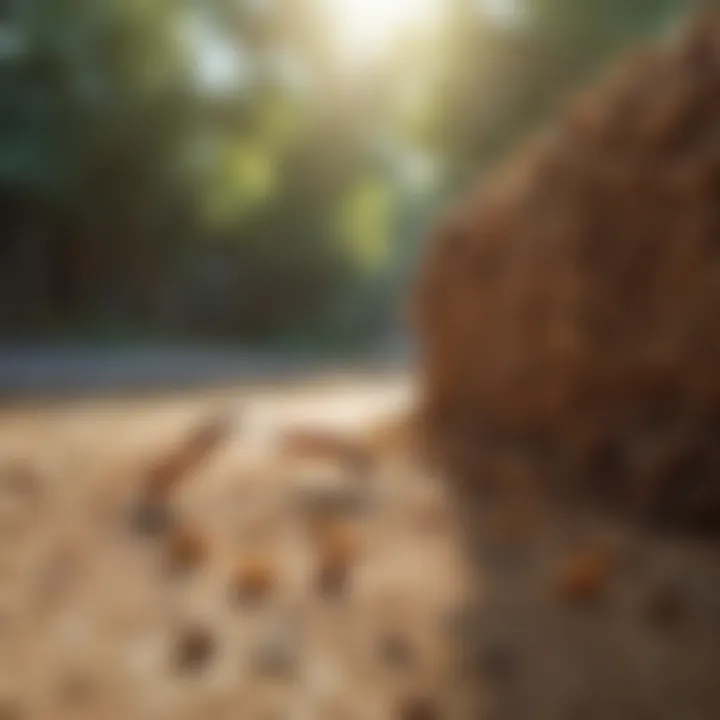
Once you've pinpointed the location, the installation is where the rubber meets the road. It’s not a one-size-fits-all routine; tact and precision matter. Here are some pointers to guide this phase:
- Depth Matters: Install bait stations at least 5-10 feet away from the structure, sinking them 3-4 inches into the soil. This depth keeps them hidden but accessible to foraging termites.
- Spacing: Use a spacing of about 10 to 20 feet between each bait station, depending on the level of infestation and activity. Too close, and you might dilute their effectiveness; too far, and termites might miss them entirely.
- Regular Intervals: Install the bait stations in regular intervals around the perimeter of the susceptible structures, ensuring that all potential entry points are covered.
Effective bait installation is an art form, significantly increasing the likelihood of intercepting termites before they can wreak havoc.
Monitoring and Maintenance
Having bait stations in place is only half the battle; diligent monitoring and maintenance complete the picture. Homeowners often underestimate the importance of this step, leading to a false sense of security. Regular checks are essential for several reasons:
- Assessing Activity: Frequent monitoring allows you to evaluate whether termites are actively feeding on the bait. If you’re not seeing signs of consumption, you may need to adjust the bait or relocate the stations.
- Replacing Bait: Baits aren’t intended to last forever. Replace them according to the manufacturer's instructions—timeliness can make a world of difference in the results you yield.
- Environmental Changes: Seasonal shifts or new constructions nearby can affect termite behaviors. Staying vigilant and adjusting your strategy according to these changes can pay off.
"Continuous monitoring can be the line between effective pest management and unwanted destruction."
Benefits of Outdoor Termite Bait
When it comes to tackling terrifying termites, outdoor bait systems offer a host of advantages that can't be ignored. Homeowners and pest control professionals alike are puttin’ their faith in these solutions for managing infestations. Understanding why these benefits matter is crucial for anyone wanting to safeguard their property from these wood-eating pests.
Eco-Friendly Pest Control
The buzz around eco-friendly pest control has gained steam over the past few years. Traditional methods, such as liquid insecticides, often lead to adverse effects on the environment and can harm beneficial insects as well. In contrast, outdoor termite baits are typically designed with environmentally safe ingredients. This means that while the baits work to target termites, they pose significantly less risk to other creatures in the ecosystem.
Using bait systems enables homeowners to manage pests without flooding their yards with harmful chemicals. These baits usually contain cellulose materials and other natural compounds. This approach can be seen as a green alternative, highlighting a growing trend toward sustainable practices in pest control. Plus, many of these products break down over time, reducing their long-term impact on soil health.
"The goal of eco-friendly pest management isn’t just to eliminate pests but to create a balanced ecosystem where beneficial organisms thrive alongside the control measures."
Long-Term Cost Efficiency
Let’s talk about the bottom line. Nobody likes to shell out money repeatedly for pest control. That’s where outdoor termite baits come into play, offering a more cost-effective solution in the long run. The initial setup may seem steep, but the payoff can be significant. With these systems, you often need less frequent treatments than with traditional chemical sprays.
By focusing on bait systems, one highlights a proactive approach rather than reactive. Once established, these baits manage termite populations effectively, cutting down on the nastiness of infestations that could otherwise lead to costly repairs. Homeowners can avoid extensive damage to wood structures, which translates to money saved.
In a nutshell, investing in outdoor termite baits can be a smart financial move. Here are a few points to consider regarding long-term savings:
- Reduced Repair Costs: By preventing termite damage early, homeowners save on potential repair costs down the line.
- Lower Use of Chemicals: Less reliance on chemical treatments reduces ongoing expenses.
- Longevity of Solutions: When properly installed and maintained, bait systems can last for extended periods, allowing homeowners to rest easy.
Challenges in Termite Baiting
Termite baiting has become a cornerstone for many homeowners as they look at ways to manage these relentless pests. However, amidst the promise of effective pest control, there are multiple hurdles to overcome. The importance of understanding these challenges cannot be understated; knowledge is power, especially when it comes to protecting one’s home from potential damage. Let's explore key elements associated with these challenges.
Resistance Issues
One of the primary concerns in termite baiting is the growing issue of resistance among termite populations. Similar to bacteria that develop resistance to antibiotics, termites can adapt over time to the substances they are frequently exposed to – including those found in bait systems. This phenomenon often occurs when the same bait is used repeatedly without rotation or diversification in formulation.
- Why is this important?
When termites become resistant to bait, it not only undermines the effectiveness of the baiting strategy but could also lead to more severe infestations that are harder to manage. - How does this happen?
Simply put, if termites continually encounter the same type of bait, some will survive and eventually reproduce, passing on their resistant traits. This creates a more challenging pest that might require higher concentrations of active ingredients, which can increase costs and raise concerns regarding safety and environmental impact.
"Building resistance in termite populations may lead to increased pest management costs and ineffective control strategies."
Environmental Factors
Another significant barrier to effective termite baiting comes from the environment itself. Variables such as weather conditions, soil composition, and moisture levels can heavily influence bait performance and termite behavior.
- Weather Conditions: Extreme temperatures, rainfall, or drought can affect the feeding patterns of termites, which in turn impacts how effectively baits can be utilized. For instance, heavy rain can wash away bait stations or dilute the active ingredients, making it less attractive to termites.
- Soil Composition and pH Levels: The structure and chemical makeup of the soil where bait is placed can also play a crucial role. Certain soils may hinder the delivery of bait to termite colonies or inhibit the bait's effectiveness, requiring careful selection of installation sites.
- Moisture Levels: Termites are drawn to moist environments, and if bait stations are situated in low-moisture areas, they may not attract termites effectively. Conversely, too much moisture can lead to rapid degradation of baits.
To combat these environmental factors, it's essential to monitor conditions and adjust bait placement strategies accordingly. A well-placed bait system considering these variables can greatly improve overall success in managing termite populations.
Understanding these challenges and formulating strategic responses is vital for effective termite baiting, ensuring a home's defense mechanism against this persistent pest is both resilient and adaptable.
Case Studies and Applications
The exploration of outdoor termite bait can be vastly enriched through analyzing real-world case studies and applications. This approach allows us to grasp the pragmatic application of theoretical concepts, linking what one reads about bait systems directly to the outcomes observed in actual situations. Understanding these elements not only reinforces the efficacy of termite bait but also highlights the variety of challenges and triumphs faced by homeowners and pest management professionals. This section will delve into specific case studies showcasing success stories as well as situations where the intended outcomes were not achieved, providing valuable lessons learned.
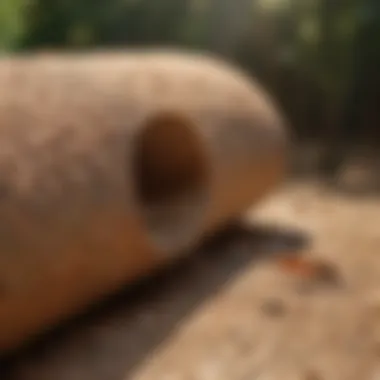
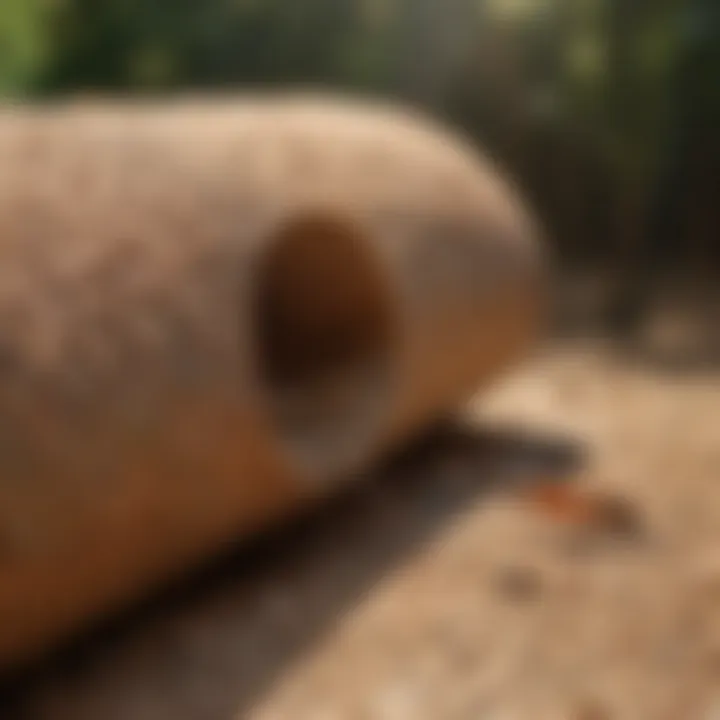
Successful Termite Management with Bait Systems
Numerous instances exist where termite bait systems have proven effective in managing termite infestations. One notable case involved a homeowner in Florida who noticed signs of termites in his wooden deck. Upon consultation with a pest control expert, a cellulose-based bait system was deployed around the perimeter of the property. This particular bait formulation attracted the foraging termites, which then consumed the bait and transported it back to the colony. Within a few months, significant reduction in termite activity was reported, illustrating the power of this approach.
The benefits are not just limited to one-off successes. In another instance, a neighborhood in California adopted a community-wide baiting strategy after discovering multiple homes affected. The shared effort not only controlled the infestation but also reduced costs through bulk purchasing and collaborative monitoring efforts. Such examples illustrate that with proper planning and execution, outdoor bait systems can effectively curb termite populations at both individual and community levels.
"The collaborative approach turned out to be a game changer, showing us that when we join forces, the results can be remarkably better."
Moreover, these success stories indicate other potential advantages. Homeowners reported less anxiety and a greater sense of control over their environment, knowing they were actively combating a significant threat to their properties. It also fosters a greater awareness regarding the importance of termite management and the tools available to them, leading to pro-active efforts rather than reactive measures.
Lessons Learned from Failures
However, the journey towards effective termite management is not without bumps along the way. There are lessons gained from failures too, often highlighting crucial variables that should be kept in mind during bait deployment. Take for example a situation in Texas where a homeowner opted for an insect growth regulator bait but failed to comprehensively evaluate the environment where it was placed. The bait was installed near a lush flowerbed, resulting in low acceptance and minimal interaction by the termite population due to alternative food sources available nearby.
Moreover, some reported cases lacked consistent monitoring, meaning that by the time the homeowners realized the bait was ineffective, the pest problem had escalated. These failures emphasize the necessity of regular checks and adapting strategies based on observed behaviors.
Homeowners should ensure that they are utilizing the right baits for their specific situations and environmental conditions. In an instance where a bait system was applied without considering the moisture levels in the soil, a failure in bait interaction with termites was documented, leading to prolonged infestations. It’s crucial to recognize that not every bait solution fits every circumstance.
In summary, while many reports underline the success of outdoor termite bait systems, the associated failures provide equally important insights. They serve as cautionary tales that stress the importance of analyzing local conditions, precise bait selection, and ongoing monitoring.
Culmination
By examining both successful interventions and lessons learned from less favorable outcomes, homeowners can gain a more rounded perspective on implementing outdoor termite bait systems. Knowledge is power, and understanding these real-life examples enhances the ability to tackle termite challenges more effectively.
Future Trends in Termite Bait Technology
The world of termite management is not static; it's continually evolving. Future trends in termite bait technology will play a pivotal role in shaping effective strategies for homeowners grappling with infestations. Environmental considerations, alongside efficiency in pest control, will drive innovations. This section will discuss anticipated developments that could revolutionize how we approach outdoor termite baiting.
Innovations in Bait Formulation
New formulations of termite bait are on the horizon, tailored to attract and eliminate termites more efficiently. These innovations may include:
- Targeted Attractants: Future baits might use pheromones or plant-based extracts that specifically appeal to certain termite species, ensuring a focused and effective approach.
- Nutritional Enhancements: Baits embedded with nutritional supplements could improve how quickly termites consume the bait, leading to better colony disruption.
- Sustainability Factors: Eco-friendly ingredients are becoming a priority, leading to baits that are less harmful to non-target species and the environment. This shift ensures that the solutions used don't have collateral damage.
"Innovations that prioritize both efficiency and safety will set a new standard in handling termite challenges," notes pest control experts.
As these formulations continue to develop, they promise to deliver not only effectiveness but peace of mind for homeowners worried about their ecological impact.
The Impact of Technology on Pest Management
Technological advances have already altered how pest management is approached, and termite control is no exception. Here are some elements to watch:
- Smart Monitoring Systems: The integration of IoT devices will allow homeowners to monitor bait stations remotely. They can receive alerts when termites take the bait, enabling timely responses.
- Data Analytics: The use of big data can enhance our understanding of termite behavior, leading to improved bait strategies that adapt to termite activity patterns.
- Biotechnology Applications: Genetic modifications may allow for the development of baits that specifically target termite health by disrupting their reproduction or digestive processes without harming other organisms.
By embracing these future trends, both pest management professionals and homeowners stand to benefit significantly. The guaranteed efficiency, along with a greater understanding of ecosystem impacts, will reflect a more thoughtful approach to pest control. As we navigate these changes, balancing effectiveness with sustainability will be the key challenge and opportunity.
Finale
As we draw the curtain on this exploration of outdoor termite bait, it’s clear how crucial an understanding of this subject can be for homeowners and pest management professionals alike. When tackling termite infestations, being informed isn’t just beneficial; it’s essential. The insights gained from this article provide a roadmap, highlighting the effectiveness and versatility of bait systems. Here are several key takeaways regarding the importance of outdoor termite bait:
- Holistic Approach: Outdoor termite bait engages a more humane and environmentally considerate path to pest control, addressing not just the symptoms of an infestation but the root causes.
- Cost-Effectiveness: Many homeowners often find themselves in a pickle with expensive treatments. Bait systems, when implemented properly, can yield savings in the long run, alleviating financial strain without sacrificing efficacy.
- Sustainability: As society becomes more environmentally conscious, the push towards eco-friendly pest control methods is not just a trend. It represents a necessary shift in practices.
By understanding outdoor termite bait, you arm yourself with knowledge that can mean the difference between a recurring infestation and a long-term solution. The knowledge gained transcends just pest control; it embodies responsible living and caring for our environment.
Summarizing Key Insights
The journey through the nuances of outdoor termite bait has illuminated several critical points. To summarize:
- Types of Baits: Comprehending the different types of outdoor termite baits, such as cellulose-based options and insect growth regulators, empowers individuals to choose more effectively based on specific circumstances.
- Implementation Techniques: Effective deployment is just as crucial as the types of baits used. Wise choices in bait placement and installation can significantly affect outcomes.
- Long-Term Perspective: Recognizing that pest management isn’t a one-off task can yield better results. Regular monitoring and maintenance ensures your chosen method remains effective over time.
These insights offer a solid foundation for anyone looking to safeguard their home against termites while prioritizing eco-friendly practices.
Encouraging Responsible Pest Management Practices
Adopting responsible pest management practices goes beyond just utilizing bait systems; it's about fostering a mindset that prioritizes safety and sustainability. Here are some practical steps:
- Educate Yourself and Others: Understanding how different bait systems work and their ecological effects can empower homeowners to make informed decisions. Sharing knowledge can help communities adopt safer practices.
- Collaborate with Professionals: Leave no stone unturned by consulting with pest management experts. Their insights can be invaluable; they recognize the intricacies of behavior patterns in pests that laypeople often overlook.
- Engage with Local Regulations: Always be aware of the regulations and recommendations in your area regarding pest control. Aligning with these practices ensures that you are acting both responsibly and legally.
- Embrace Integrated Pest Management (IPM): This method combines different management tools and strategies to minimize risk while achieving pest control goals. Baits are just one part of this broader strategy.
By nurturing a responsible approach to pest control strategies, homeowners not only safeguard their properties but also contribute to a healthier planet. Taking these steps reflects a commitment to a better future, one where both our homes and our environment thrive together.



